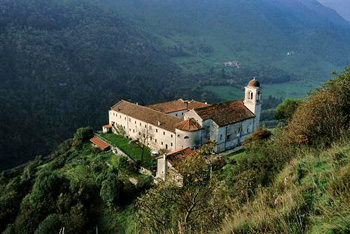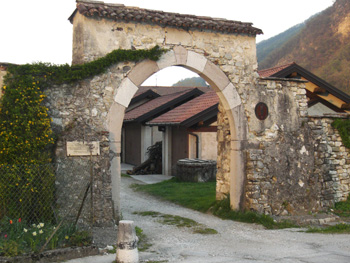| Card n. | Description | Locality | Linked sites |
| 77 | Anzù | Feltre | 32 - 33 - 117 |
| file .pdf | Architecture Art History (ASA) | Google maps |
 |
 |
- Description
- How to get there
- Interesting facts
- Bibliography
The delightful setting of the village of Anzù is well worth a visit. Wedged between the steep slopes of Monte Tomatico and Monte Miesna is a narrow strip of land composed mostly by marshes and swamps that have formed around the unstable Sonna torrent, an affluent of the Piave that has worn away the valley. The area was once a compulsory route for those travelling from the Marca Trevigiana area to Feltre and viceversa. In a dominant position is one of the most important elements in what was once Feltre’s defence system, the Sanctuary of San Vittore and Santa Corona (32 HAA), and further down, at 257 m a.s.l,, is the site where duties were once paid, the house of the President of the traditional fair of Anzù and the remains of the ancient Hospital (33 HAA/ES). The “Osteria della chiusa” complex, the appearance of which suggests a sixteenth- century origin, actually presents an earlier structure, evident at several points as a result of the thickness of the walls and the building techniques used. Visible just below is the excavation work carried out in 1971, which brought to light the barrage tower and the wall that were part of the defence system and that were used until at least the 14th century, before the Venetian troops definitively conquered Feltre in 1419. The house of the President of the fair follows the classic fifteenth-century villa pattern, characterised by a central core flanked by two annexes, all on two floors. The distinctive feature of the main facade are the seven pilasters that break up the regular pattern of the windows and doors. The architectural structures have been reconverted by private individuals, and all that is left today is the arch that led into the hospice; the main important historical and artistic elements, however, are to be found outside and in its position higher up than the bed of the torrent. The Sanctuary of San Vittore and Santa Corona was built in 1096 over an earlier place of worship, and was consecrated by the Bishop of Feltre, Arpone, on 13 May 1101. The church, in Romanesque style with evident Byzantine influences, has a triple-nave Greek cross layout with a transept and central cupola, and is preceded by a porch built by the monks of Fiesole in the 17th century.
The Osteria della Chiusa complex can be reached by going along Via Dazio Vecchio, a little dirt road parallel to today’s main SR348 road.
ACCESSIBLE: outside only
MUNICIPALITY: Feltre
PLACE: Anzù
GEOGRAPHICAL COORDINATES: Customs post X 1727584 - Y 5098691. Sanctuary of S. Vittore X 1727770 – Y 5098417
PROVINCE: Belluno
FILE COMPILED BY: Visentin/Vallerani
Nearby is a nature reserve known as the Osiery of Cellarda (117 NS), so called because in 1901 the Forestry Corps used it for growing willow for basket making. This protected area is largely flat and is situated on the right bank of the Piave, the branches of which form small marshes, ponds and little streams fed by springs and sources, creating a biotope of international importance.
F. Magani, L. Majoli, Tesori d'arte nelle chiese del bellunese. Feltre e territorio, Belluno, 2008
F. Coden, Il santuario dei Ss. Vittore e Corona a Feltre, Belluno, 2004.
S. Claut, San Vittore restauri e studi, Tipolitografia DBS, Seren del Grappa, 1996

